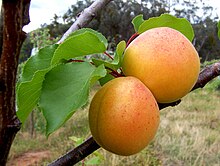Prunus armeniaca
| Prunus armeniaca | |
|---|---|
 |
|
| Apricot fruits | |
| Scientific classification | |
| Kingdom: | Plantae |
| (unranked): | Angiosperms |
| (unranked): | Eudicots |
| (unranked): | Rosids |
| Order: | Rosales |
| Family: | Rosaceae |
| Genus: | Prunus |
| Subgenus: | Prunus |
| Section: | Armeniaca |
| Species: | P. armeniaca |
| Binomial name | |
|
Prunus armeniaca L. 1753 not Thunb. 1784 nor Blanco 1845. |
|
| Synonyms | |
Prunus armeniaca ("Armenian plum"), the most commonly cultivated apricot species, also called ansu apricot,Siberian apricot,Tibetan apricot, is a species of Prunus, classified with the plum in the subgenus Prunus. The native range is somewhat uncertain due to its extensive prehistoric cultivation, though almost certainly somewhere in Asia. It is extensively cultivated in many countries and has escaped into the wild in many places.
Prunus armeniaca is a small tree, 8–12 m (26–39 ft) tall, with a trunk up to 40 cm (16 in) in diameter and a dense, spreading canopy. The leaves are ovate, 5–9 cm (2.0–3.5 in) long and 4–8 cm (1.6–3.1 in) wide, with a rounded base, a pointed tip and a finely serrated margin. The flowers are 2–4.5 cm (0.8–1.8 in) in diameter, with five white to pinkish petals; they are produced singly or in pairs in early spring before the leaves. The fruit is a drupe similar to a small peach, 1.5–2.5 cm (0.6–1.0 in) diameter (larger in some modern cultivars), from yellow to orange, often tinged red on the side most exposed to the sun; its surface can be smooth (botanically described as: ) or velvety with very short hairs (botanically: ). The flesh is usually firm and not very juicy. Its taste can range from sweet to tart. The single seed is enclosed in a hard, stony shell, often called a "stone", with a grainy, smooth texture except for three ridges running down one side.
The origin of the species is disputed. It was known in Armenia during ancient times, and has been cultivated there for so long, it is often thought to have originated there.Seeds of the apricot have been discovered during archaelogie excavations of the Garni Temple and Shengavit settlement, having a history of 6 000 years. Its scientific name Prunus Armenian (Armenian plum) derives from that assumption. For example, De Poerderlé, writing in the 18th century, asserted, "Cet arbre tire son nom de l'Arménie, province d'Asie, d'où il est originaire et d'où il fut porté en Europe ..." ("this tree takes its name from Armenia, province of Asia, where it is native, and whence it was brought to Europe ..."). An archaeological excavation at Garni in Armenia found apricot seeds in an Eneolithic-era site. Despite the great number of varieties of apricots that are grown in Armenia today (about 50), according to Vavilov its center of origin would be the Chinese region, where the domestication of apricot would have taken place. Other sources say that the apricot was first cultivated in India in about 3000 BC.
...
Wikipedia

